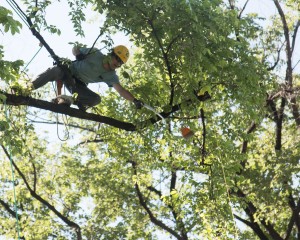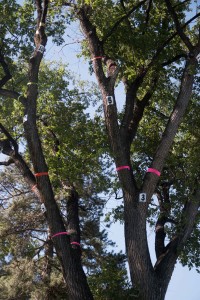
The phrases “completely exhausting,” “adrenaline rush” or “life-saving” are not typically associated with tree climbing. But this weekend they fit.
Every year Utah hosts a climbing competition that gathers participants from across the state to scale some of the largest trees along the Wasatch Front. This year the event was hosted on June 6 and 7 in Pioneer Park in Provo, and dozens of climbers, official judges and volunteers turned out to support the competition.
The event has been gaining popularity over the last few years. Event officiator Scott Bunker expressed his optimism for the community to learn about professional tree climbing, stating the event is “a good opportunity for people to see what climbers do and observe the skill and talent that comes with it.”
The Utah Community Forestry Council and International Society of Arboriculture were in charge of the 20th annual tree climbing event, which hosted five separate events. The events included the following:
The Work Climb — A race to reach bells placed across the canopy of a tree. Climbers swing from branch to branch and tap bells in under five minuets.
Arial Rescue — A mock tree climb rescue of an injured individual. The scenario proposes the injured victim will be considered deceased if not safely returned to the ground in five minutes. Judges also look for specific communication and first aid to be shown to the dummy victim.
The Speed Climb — A race to scamper up a tree as quickly as possible, with the fastest competitors climbing to treetops in under 30 seconds.
The Secured Foot Lock — A race reminiscent of high school gym class. The most physically draining event to see who can climb a free dangling rope the fastest.
Throw Line — A challenge for climbers to strategically position themselves to throw balls through sets of branches far out of reach.
Each climber receives points for competing in all events, and a total score is given. The highest scores a medal, and the champion moves on to compete nationally in Milwaukee in August.

Last year’s 2013 Utah champion Nick Bleckert, who works for Trees Incorporated, expressed the reason he chose to go into climbing as a profession:
“I love what I do; I get to climb every day, and it’s never the same tree or the same climb,” he said. “It’s a natural high … no drugs needed.”
Bleckert, a West Valley native, recounted that he has saved multiple individuals who were injured in trees.
“Helping people comes with the job. I like to think that if others would work hard to get me down, I will work hard to get you down.”
Many of the climbers work for companies that deal with tree clearing, trimming and removal. They also get hired frequently by power companies to assist with overhead power fixtures or are called in for emergency situations caused by inclement weather.
Thirteen-year veteran Tyler Guerts talked about climbing as a service to help kids reclaim their lost pets as well. This, he said, is a fairly common occurrence.
“We get calls for cats in trees, which isn’t the most exciting thing, but when you arrive there and hear them crying way up in the tree you can’t help but go up and get it,” he said.
Ultimately, the event aimed to show that when they are not saving kittens or competing for the title of Master Climber, these unsung heroes are helping to maintain the city safety overhead.
To learn more about professional tree climbing, find more events this year or inquire about additional information regarding the Utah Forest Council, visit www.utahurbanforest.org.




